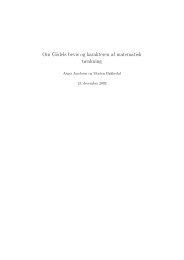Master Dissertation
Master Dissertation
Master Dissertation
Create successful ePaper yourself
Turn your PDF publications into a flip-book with our unique Google optimized e-Paper software.
We want to show by induction that for x ∈ [a + m − 1, a + m],<br />
|f(x)| ≤ |f(a)| + m. (6.8)<br />
For m = 1, let x ∈ [a, a + 1] then we may write x = a + k for some<br />
k ∈ [0, 1]. Then<br />
|f(a + k)| = |f(a + k) − f(a) + f(a)| ≤ |f(a + k) − f(a)| + |f(a)|<br />
≤ |f(a)| + 1.<br />
In the (n + 1)th step, let x ∈ [a + n, a + n + 1]. Then there exists a<br />
kn ∈ [0, 1] such that x = a + n + kn and<br />
|f(x)| = |f(a + n + kn)| = |f(a + n + kn) − f(a + n) + f(a + n)|<br />
≤ |f(a + n + kn) − f(a + n)| + |f(a + n)|<br />
< |f(a)| + n + 1<br />
by the induction hypothesis. This concludes the proof by induction.<br />
Clearly if x satisfies (6.8), then it is also satisfied by all y ∈ [a, a + m] and<br />
we have proven that f is bounded on the interval [a, b].<br />
Corollary 6.5. Let f(x) = ln r(e −x ). Then there exists a constant x0 such<br />
that f is integrable on every interval [a, b] where x0 ≤ a.<br />
Proof. This follows directly from the definition of integrability since f is<br />
measurable and bounded on [a, b] by Lemma 6.4.<br />
Lemma 6.6. Let a ≥ x0 from Lemma 6.4. Then f(x) = ln r(e−x ) can be<br />
represented for all x ≥ a as<br />
f(x) = g(x) +<br />
x<br />
a<br />
h(s)ds, (6.9)<br />
where g and h are measurable and bounded on every interval [a, b] and<br />
g(x) → g0 (|g0| ≤ ∞) and h(x) → 0 for x → ∞.<br />
Proof. Let x ≥ a we may write f(x) on the form (6.9) by letting<br />
g(x) :=<br />
x+1<br />
FIXME: maybe write out the above<br />
By (6.4) h(x) → 0 for x → ∞.<br />
x<br />
f(x) − f(s)ds +<br />
a+1<br />
h(x) := f(x + 1) − f(x)<br />
44<br />
a<br />
f(s)ds



